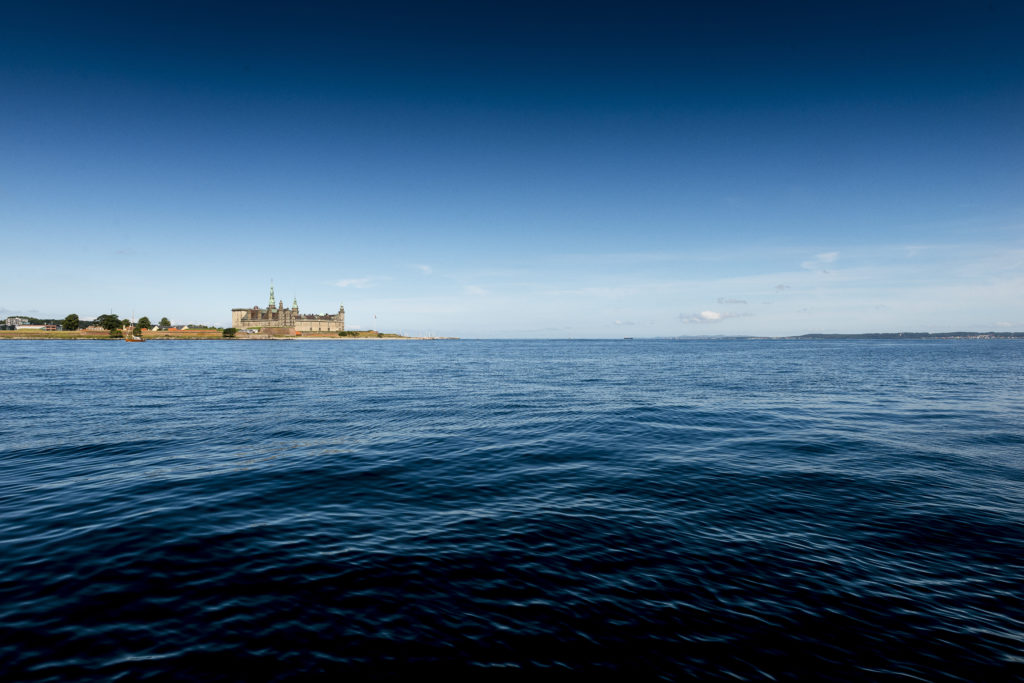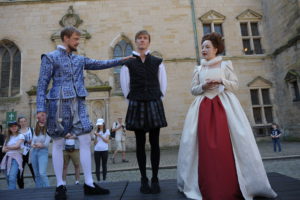What emerges from watching ‘Hamlet Live’ is a simultaneous sense of familiarity and distance that can help us think about how literatures travel and come to be shared
The Danish city of Helsingør is known for two things. One is its proximity to Sweden. Plying a distance of just four kilometres, the ferry route between Helsingør and the Swedish town of Helsinborg is one of the busiest in the world. The town’s other claim to fame, meanwhile, is rooted firmly on dry land. Kronborg Castle is an opulent fifteenth-century fort that occupies the northeastern-most tip of the island of Zealand, Denmark’s largest. And it is this bastion which William Shakespeare reputedly used as the basis for his tragedy Hamlet. As part of the Institute for World Literature 2017, July Blalack and I visited the castle on a day-trip from Copenhagen.

Kronborg Castle from the Øresund (Thomas Rahbek, courtesy of Kongelige Slotte press archive)
The castle and its surroundings are beautiful. The original fortress was built in the 1420s by Eric of Pomerania. It was transformed into the Renaissance stronghold we see today under Frederick II, who ruled between 1574 and 1585. Since its founding, the castle’s position at the narrowest point of the Øresund allowed it to tax ships wishing to enter Danish waters. These Sound Dues were integral to funding the castle’s development and refurbishment until they were abolished in the nineteenth century. The interior of the castle, though now sparse, gives some indication of its previous grandeur. The collection of sixteenth-century tapestries reveal Frederick II’s attempts to tie together strands of Danish mythology under his kingship. The views from the tallest tower, meanwhile, suggest how the Danes hoped to impress – and intimidate – their Swedish neighbours.
But of most interest to MULOSIGE is the castle’s emphasis on its links to the famous Prince of Denmark. Though the origins of the play are debated – with William Hansen’s work on Saxo Grammaticus and Hamlet playing a key part – Kronborg is often cited as the Elsinore Castle in which Shakespeare’s Hamlet is set. The modern-day castle appears unwilling to let such an association slide. Throughout the summer, productions of Kronborg’s ‘Hamlet Live’ take place all over the castle, including the central courtyard and chapel. One segment – the appearance of the ghost of Hamlet’s father – even occurs in part of the castle’s old cellars. The performance itself has its am-dram moments, but the playful breaking of the fourth wall offers moments of humour that might otherwise be lost. The lavish costumes, too, add a levity to the play’s high tragedic moments.

Hamlet Live, Kronborg Castle (Tobias Fonsmark, courtesy of Kongelige Slotte press archive)
Hamlet, of course, remains one of Shakespeare’s most popular and most performed plays. (Just this week, tickets to a limited-run production directed by Kenneth Branagh and starring Tom Hiddleston were balloted off to great acclaim in London.) But what is so interesting about the repeated, summer-long performances of ‘Hamlet Live’ is the way they situate the play. This story, now most famous in its Elizabethan English version, has found its way back to its putative home. The setting is thoroughly Danish, yet the language remains thoroughly English. Though the linguistic constraints of Shakespeare’s original are loosened slightly, and the language is modernised in parts, the tone remains antiquated. The shortened scenes in ‘Hamlet Live’ draw from Shakespeare’s script while also exerting creative licence; the famous lines are there, but the iambic pentameter is mostly missing.
At first, hearing Danish actors in this Danish setting speaking something approximating the Queen’s English has an unsettling effect. But it soon becomes apparent just how familiar – and how resonant – a work like Hamlet remains. Those watching the performance were not simply Brits looking for their (in?)frequent fix of a national literary treasure, but visitors from all around the world. The language almost becomes unimportant. As publicity for ‘Hamlet Live’ suggests, while ‘the characters in “Hamlet Live” speak English … knowledge of English is not necessary for understanding the drama’ of the production. In the midst of these Danish and English particularities, an almost universal idea of drama raises its head.
In this instance, neither language nor geography act as a limit on the work. Hamlet, accordingly, is able to be both particularly local and transnationally extensive all at once
While it is tempting to embrace such an expansive understanding of Hamlet, this universal characterisation of drama has obvious limitations. Nevertheless, what emerges from watching such a production is a simultaneous sense of familiarity and distance that can help us think about how literatures travel and come to be shared. In the case of ‘Hamlet Live,’ the act of performance reaffirms the pervasiveness of the narrative, tying it to its not-so-humble geographical and temporal origins yet bringing it to an eclectic audience in the twenty-first century. In this instance, neither language nor geography act as a limit on the work. Hamlet, accordingly, is able to be both particularly local and transnationally extensive all at once.
Drawing such conclusions from an English work like Hamlet is, of course, quite straightforward. This is a widely-known story, not only in English, but in its many successful translations. (A well-received Spanish translation by María Fernández Ache was staged at Madrid’s Matadero in 2012, while Katherine Hennessey has drawn attention to Arabic adaptations of Shakespeare in Yemen.) What a project like MULOSIGE does is help us seek out similar examples in literatures outside hegemonic European languages. English is by no means the only medium through which works circulate on such a grand scale, and nor is it just the works of Shakespeare that cross linguistic, geographical and temporal boundaries. Watching ‘Hamlet Live’ underlined the importance of seeking out these examples and understanding the breadth of their significance. The spectre of such possibility should motivate us in our search – though hopefully our ends won’t be quite as sticky as Hamlet’s…


Leave A Comment